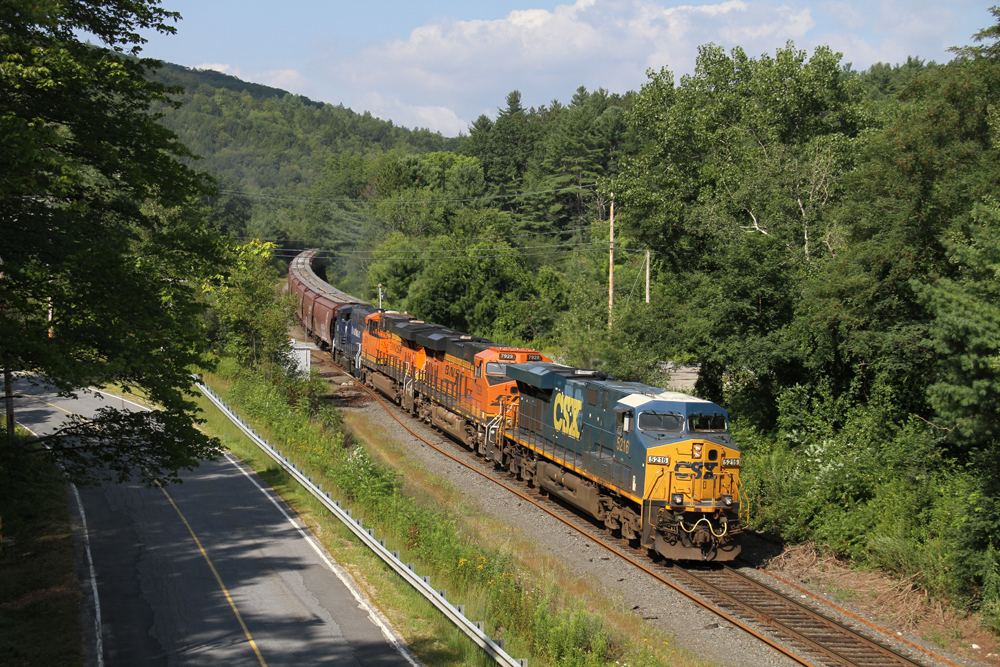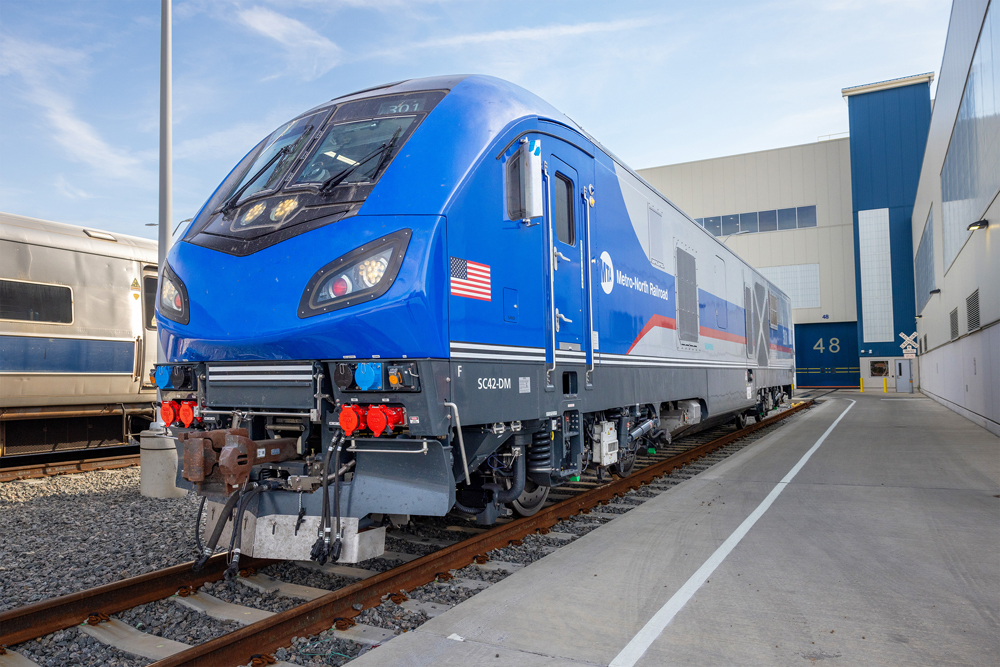
The Surface Transportation Board took 33 pages to explain why it rejected Canadian National’s request to put Kansas City Southern into a voting trust while their proposed merger would be placed under the regulatory microscope.
Buried on Page 31 of the board’s decision is a 105-word passage that – aside from a potential Canadian Pacific-KCS merger – slams the door shut on future Class I combinations. Yes, in just three sentences, the board explained why we’ll never see a transcontinental merger under the current review rules:
“Neither Applicants nor the Board can perfectly predict future strategic responses to a CN-KCS transaction. However, a simple geographic analysis of the rail network would suggest that a carrier in CP’s position, i.e., one that would be the smallest carrier by far after a CN-KCS combination, might need to look for potential strategic alliances, which might in turn trigger yet more strategic responses by other rail carriers,” the board wrote. “Approval of a CN-KCS voting trust could speed up downstream consolidation movements prior to the Board even having had an opportunity to assess them based on the record yet to be developed in this proceeding.”
Substitute any other combination for CN-KCS – such as BNSF Railway-Norfolk Southern or Union Pacific-CSX Transportation – and you see the problem. Any big merger would prompt the remaining railroads to seek merger partners, and the dominoes would begin to fall toward two go-everywhere systems that blanket the U.S. and Canada.
That’s not in the public interest, the STB says, because a second merger application would arrive at its front door before the board had a chance to review the first megamerger. In other words, this short passage in the board’s CN-KCS voting trust decision is, in effect, a merger moratorium.
Voting trusts are a crucial first step in any merger process. They allow the shareholders of the railroad being acquired to receive their cash and stock up front, before the merger undergoes the lengthy STB review process that could last 18 months. Without a voting trust, investors wouldn’t see a dime until the merger is approved. They’re unlikely to wait around that long. Wall Street is all about show me the money – and now, please.
An exception to the board’s de facto merger moratorium would be a CP-KCS combination. The STB has already approved CP’s request to place KCS in a voting trust and said it would review a CP-KCS merger under its less onerous, pre-2001 merger review rules. If you consider that the old rules are what produced today’s big systems in the East and West, then the end-to-end CP-KCS merger should be a slam dunk in Washington.
And if CP and KCS tie the knot, the North American railroad map would be almost perfectly balanced. You’d have two railroads in the East (CSX and NS), two in the West (BNSF and UP), and two systems spanning Canada that also reach the Gulf Coast and, in the case of CP, deep into Mexico via KCS de Mexico. UP, which serves all of the important Mexican gateways, has a 26% stake in the biggest Mexican railroad, Ferromex.
The Class I railroad map also would be frozen in time. Forever. End of story. The fan within all of us may cheer the fact that there would be no more fallen flags to mourn, no variety lost, no distinctive rail logos swept into the dustbin of history.

But this STB decision is unfair because it cements an advantage trucks have over railroads. Trucks can go anywhere. Railroads can go only as far as their maps will take them. Interchanges at Chicago, Memphis, and other gateways between East and West add delays, make service unreliable, and force customers to deal with more than one railroad. It is a recipe for continued loss of rail traffic to the highway.
If the STB wanted to create a level playing field between trucks and trains, it would figure out a way to preserve rail-to-rail competition while allowing Class I mergers. Canada has had success with two transcontinental systems for a century. It can work in the U.S. of A. too – if only the STB would allow it.
Rodney Case, a railroad consultant, puts it this way: “The STB would do well to note that while railroads carry 40% of ton miles, by revenue they are less than $100 billion of a $1.4 trillion U.S. surface transportation and logistics market. Killing the goose is a real risk when the wolves are growing so large.”
You can reach Bill Stephens at bybillstephens@gmail.com and follow him on Twitter @bybillstephens













”
Canada has had success with two transcontinental systems for a century.
”
Because most folk require success to call something successful. Canada couldn’t sustain 2 trans cons. CN lived off of the govt $$$ for around 75 years.
But Canada doesn’t bring up an interesting aspect. For much of it’s history, CP had steamships, airplanes + hotels. Maybe what the railroads need are some ships, planes + warehouses?
FedEx wouldn’t have been such a success if they stuck to just airplanes. Same with UPS had they stuck to trucks + not embraced airplanes. Maybe what the railroads really need is something other than more trains.
Simpler solution to the merger problem…100% open access, a private institution that owns all the track(doesn’t need to be government like Europe) and then the railroads pay to use that track…with the cost set by the STB using the same formulas they use now.
It’s a bit simplistic to say two carriers are okay because Canada did it. We have a much smaller population spread over a much larger area. We tries multiple transcons, and all but one of them had to be Conrailed because we didn’t have the market to support them all.
I agree with Timothy to a point. There is certainly an advantage to being able to offer single-carrier service to a larger area. On the other hand, the STB needs to preserve, and under the new rules, increase competition in order to approve a significant transaction,
CN-KCS reduces competition in 3 ways.
1. Parallel lines between New Orleans and Baton Rouge. CN has shown a willingness to deal with this by selling one line.
2. Generally parallel, but distant lines connecting the upper Midwest with the gulf coast. This could be remedied if CN were willing to sell CP the KCS lines between Kansas City and New Orleans.
3. Captive shippers are now captive for the entire haul. As an example, let’s say a customer in Mexico ships to somewhere on Pan Am. The shipment has to start out on KCS but the customer would have the option of using many combinations of UP. BNSF, CP, CN, NS, or CSX to get to Pan Am. A merger with CN (or CP) would allow that railroad to offer single carrier service all the way to Pan Am. However, CN/KCS (or CP/KCS) might use that as an opportunity to raise rates, or they might still offer poor service, and the customer would have no ability to require KCS to interchange the traffic to another carrier of their choice. This can be remedied by requiring KCS keep existing gateways open. This allows customers to use KCS’ new single carrier service, but also allows them to require KCS to interchange traffic to another carrier if they so choose.
I can certainly understand the premise that bigger is never better and most of us are not a fan of a big companies, I have worked for the biggest, to a mom & pop and now with a mid size company in my industry. So far the mid size has been the best while at same time given me some stability of what the future holds.. But when it comes to logistics, or transportation I just don’t understand why railroads should still be geographically limited by essentially gov’t regulation when rails obviously cross the country and as others noted are truly competing against other forms of transportation as well..
…
Why shouldn’t KCS go to the highest bidder between CN or CP when their is little or no overlap & STB can grant trackage rights to specific corridors just as they would do if CSX take over of Pan Am rails if approved or BNSF pursue NS or CSX if they feel as a private company it is gives them a competitive advantage to run a manifest train from say Kansas City to Baltimore or Seattle to Atlanta. ICC doesn’t say that UPS planes can only fly to these airports and trucks can only drive on these roads or say a tugboat company can only run their barge line on the Ohio River and must pass off the barges to another tug company on the Mississippi River. I just find the underlying premise that in this day and age that a railroad engaged in interstate commence can and should be limited to a geographical area is not right and separate issue on how the perform.
Charles, in your first post you wrote, “The mergers I support are…and CP+Pan Am”. Didn’t you mean CSX+Pan Am”. Which leads me to ask if Mr. Stephens is saying the STB will reject ALL new merger applications or only transcontinental ones leaving regional ones some hope for approval. Clearly, CSX+Pan Am isn’t transcontinental but what Mr. Stephens writes in his opening seems to say that too will be rejected.
L Reiser hit the bullseye. If any of these RRs were serious, they would be working to INCREASE service/billable carloads. The inability of getting unit IM trains across Chicago in less than a day is disgusting. Change the crews, do the inspection/refueling, GO. Draying across town is proclaiming incompetence. Extorting taxpayer subsidies to build needed upgrades made necessary by post merger track abandonments is ridiculous.
In the specific case of KCS, I as a stockholder voted against CN. I believe we should be offered a chance to vopt for or against CP–perhaps a simple contest between the two.
Just an opinion, when the railroads put more emphasis on serving their customers and less on the stockholders then they might be more competitive.
Photo taken at Wendell, Massachusetts. Which I never heard of so I looked it up. Franklin County, population 848 souls, one of many among the Bay State’s 351 cities and towns with fewer than a thousand population (there are a handful with fewer than 100 people). Significance? Massachusetts (along with Rhode Island and Connecticut) has no county government, so a town with a few hundred people is the local unit of government to provide whatever services are to be provided. Anyway, civics lesson aside, Massachusetts is a geographically bigger state than most people think, with lots of rocks and trees and steep hills and not many people for goodly stretches. To get a freight car from either Albany – area gateway, Selkirk or Mechaniville, to say, Brockton, Taunton or Braintree, is a feat of very creative railroading. Let’s not make it more difficult by a measure which could lessen competition and/or lead to the abandonment of the railroad line shown in the illustration.
Mergers for or against are not what keep railroads from competing with other modes. Nor are “gateways” the problem. It is a series of mind sets by management and especially their speculators/investors that never lets them think of themselves as a single system that trades parts but is built to look at the long term and to grow business for each and for all. Regulators as presently constituted must be reactive, they cannot force their industries to improve themselves, but the STB does know its own history and that of the last 50 years of the railroads.
I always go by the premise that bigger is never better no matter what it is. Most combinations that I have seen have not benefited the employees or the customers. The bigger companies get, the more unwieldy they get. The only thing that benefits is CEO egos.
i don’t think this makes mergers impossible, but they will have to wait for approval to close the deal. Approval may be possible, but will probably involve a lot more concessions than past mergers. For example, if trackage rights and guaranteed gateways were used. We could theoretically have 3 systems that go everywhere. That would allow single lane service and increase competition. The RRs would have to decide if the cost of the mergers is worth the benefit.
If Bill Stephens’ theories are correct, I’m all for it. The mergers I support are CP+KCS, and CP+PanAm. Also some arrangement for sale to CP or use by CP of a direct route from West Detroit to KCMO.
After that, we’re fine. Let the four American majors figure out how to route freight through Chicagoland and through KCMO. Mergers aren’t necessary and shouldn’t happen.
So STB decision supported by the current administration supports the logic that FedEX and UPS are essentially monopolies because their is not enough competition so by logic those 2 companies should be broken into 4 companies on maybe east west basis (along the lines of their central hub locations). Just as you support the notion that a railroad company should only be limited in their geographic reach and therefore incur additional cost, inefficiencies for which rail and truck do not.
My take on the decision is that 1)Just saying it is a voting trust is a public benefit doesn’t make it so when the benefit really just goes to the shareholders of the acquired company. 2) Railroads will need to talk to broader public benefits besides rates/efficiency in a merger case.
I’d push back on the Rod Case quote. The railroad Goose does not even play in large portions of the transportation/logistics market and the data is at best mixed as to how effectively railroads are driving truck to rail conversions.
The merger playbook from the past 40 years worked really well for the industry and overall everyone has benefitted and railroads are in a much stronger place. Now they need a new playbook if further consolidation really is necessary.
Merging Class 1’s and maintaining competition is not like merging 2 top level cell phone companies to maintain a gang of 4. Railroads only merge to get scale, not to win more business. Something the cell phone companies can’t stand. They too want scale so it will reduce competition, because in reality railroads just don’t want price elasticity. So have 2 railroads in the east and 2 railroads in the west and 3 in between is just not enough national competition.
There needs to be (at a minimum) 4 transcontinental railroads in the US. CN/CP act simply as a US transcon bypass with a POE in the Gulf. To reach true US transcons and still include 2 Canadian’s as well will require we merge 2 of the 4 remaining. The politics just won’t allow it.
Bill; to your comment in the next to last paragraph; the STB has before it (since about 2016) the NITL’s Competitive Switching proposal. The Board needs to expedite consideration of this now if they are serious about rail competition.